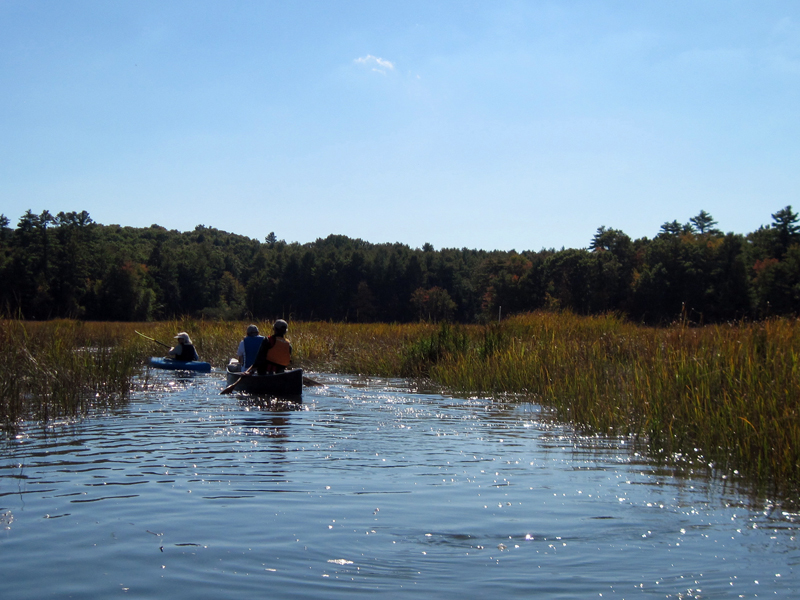
Kayaking on Sherman Marsh in Newcastle.
In Midcoast Maine, several local conservation organizations work alongside one another to improve the quality of life in local communities in many ways, including establishing a legacy of permanently conserved lands. With the help of a statewide network called the Maine Land Trust Network, the land trust community collected survey information to better understand the value of conserved lands for area residents. The full report is available through the Maine Land Trust Network and the information collected has been revealing.
Here in the Midcoast, the land trust community — Georges River Land Trust, Medomak Valley Land Trust, Midcoast Conservancy, Pemaquid Watershed Association, Damariscotta River Association, Kennebec Estuary Land Trust, and Boothbay Region Land Trust — just finished a banner year saving the lands that protect the wildlife and beauty of the Midcoast while creating opportunities for families to get outdoors, learn about nature, and support the local economy.

Snowshoeing on Whitten Hill in Montville.
In 2017, local land trusts have contributed the following to the region:
Boothbay Region Land Trust offered more than 100 free education programs including lectures, nature hikes, forest therapy walks, story trails, and an heirloom apple tasting.
Georges River Land Trust opened two new coastal preserves — Ash Point Preserve in Owls Head, with access to Muscongus Bay, and the Langlais Sculpture Preserve in Cushing, which was the estate of Maine artist Bernard Langlais. The land trust is using these preserves as well as its other 14 preserves for demonstration management projects, environmental and arts education, youth programs, and public access.
In addition to conserving special natural areas for public trails and for wildlife, Damariscotta River Association involved more than 3,400 students in its education programs both outdoors on its conserved properties as well as in local schools, building a stronger connection to the natural world among youth and adults alike.
Midcoast Conservancy is working with communities to restore 71 miles of the Sheepscot River for fish and to improve fire protection and recreational opportunities, and has partnered with more than 40 public and private landowners to stop contaminants from flowing into Damariscotta Lake and other waters of the Midcoast.
The Kennebec Estuary Land Trust had a banner year for land protection with more than 600 acres protected, including a new 50-acre preserve, which served as an outdoor classroom for local third-grade students learning about habitat for Maine owls.
Medomak Valley Land Trust conserved six new properties, reaching all corners of the Medomak River watershed from Pettingill Stream on the upper reaches of the Medomak River in Appleton to acres of forest in wildlife corridors in Waldoboro to a popular walking trail near Muscongus Bay in Friendship.
With the donation of 11.5 acres located in Bremen, Pemaquid Watershed Association was able to protect an island providing loon nesting habitat and uplands surrounded by significant marshland on McCurdy Pond. Pemaquid Watershed Association is committed to continuing its work in environmental education, water quality monitoring, and land stewardship on its 10 nature preserves open to the public.
Several of the local trusts working with other partners established a 47-mile walking trail that connects Unity to Belfast.
Thanks to Maine’s network of 80 land trusts, other regions of the state are seeing similar benefits. On Maine’s land-trust-conserved lands, the public enjoys a diverse network of outdoor recreational areas that rival those offered at state and federal parks, and, with few exceptions, use of these lands is free to all. With significantly less state-owned land in Maine as compared to other states east of the Appalachian Mountains, the independent nonprofit land trust community offers the following amenities to Maine residents across the state:
Hikers will find more than 1,250 miles of trails. These range from family-friendly nature paths to more rugged routes ending atop wind-swept summits, and everything in between.
Outdoor recreationalists can enjoy more than 275 miles of mountain bike trails, 345 miles of ATV trails, and 570 miles of snowmobile trails.
Families are invited to discover more than 200 beaches offering opportunities to swim, picnic, and observe wildlife.
Water enthusiasts can launch their canoe or kayak at more than 60 saltwater and 140 freshwater boat launch sites, provided and maintained by land trusts.
More than 90 percent of all lands conserved by Maine land trusts are open to hunting — in other words, more than 2.3 million acres, or 10 percent of the state.
As a bonus, unlike publicly owned lands, most land-trust-conserved lands are directly contributing to the local tax base. In fact, approximately 90 percent of all lands conserved by land trusts in Maine remain on the tax rolls because they are in private ownership protected with conservation easements. Additionally, land trusts pay taxes on working lands they own. These properties are also indirectly generating tax revenue by supporting local economies through the protection of more than 2.1 million acres of working forests, 36,000 acres of productive farmland, and 60 access sites for marine fishermen.
For more information on each of the land trusts, go to mltn.org. While there, check out “Land Trusts Work for Maine.” The culmination of the 2017 survey, this 12-page report outlines ways in which land trusts are strengthening Maine’s economy and enhancing communities.



